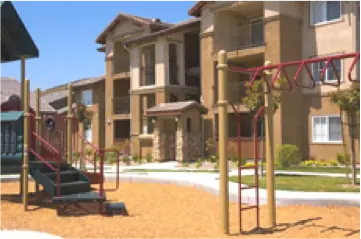Preserve Units at Risk of Conversion to Market Rates
Preserve for lower income households the assisted housing developments identified pursuant to paragraph (8) of subdivision (a).

The program for preservation of the assisted housing developments shall utilize, to the extent necessary, all available federal, state, and local financing and subsidy programs identified in paragraph (8) of subdivision (a), except where a community has other urgent needs for which alternative funding sources are not available. The program may include strategies that involve local regulation and technical assistance (Government Code Section 65583(c)(6)).
Required Components of Programs
Effective programs reflect the results of the local housing need analyses, identification of available resources (including land and financing), and the mitigation of identified governmental and nongovernmental constraints. Programs consist of specific action steps the locality will take to implement its policies and achieve goals and objectives. Programs must include a specific timeframe for implementation, identify the agencies or officials responsible for implementation, and describe the jurisdiction’s specific role in implementation.
Program Requirements
The nature of conversion risk varies significantly among projects depending on the type of subsidy and related affordability controls. Individual program responses should be tailored to the results of the analyses and specific local situations.
Actions to Monitor
- Establish an early warning system and monitor at-risk units. Create a list based on at-risk units in the ten-year inventory and analyses (conversion risk, costs, and resources) for possible conversions within the current and next planning period. Monitor the list on a regular basis (e.g. every three months).
- Publicize existing state and federal notice requirements to nonprofit developers and property owners of at-risk housing.
- Gauge owners’ intent to prepay a federally assisted mortgage. Establish a relationship and meet with property owners of at-risk units on an annual basis.
- Gauge owners’ interest in renewal and/or opting-out of federal, project-based Housing Choice voucher contracts. Determine whether profit-motivated owners intend to renew project-based Housing Choice voucher contracts. Five to twenty-year HUD contracts are available, subject to annual appropriations.
- Require owners who want to opt-out of a project-based Housing Choice voucher contract, prepay a HUD-subsidized mortgage, or sell their property within five years of the expiration of the rental subsidy to provide 18-24 months’ advance notice.
- Respond to any federal and/or state notices, including “notice of intent to prepay,” “owner plans of action,” or “opt-out” notices filed on local projects. Local governments (affected public agencies) receive these notices and should quickly respond by contacting property owners.
- Hold a public hearing on the intended opt-out, prepayment, or sale to ensure noticing requirements and potential strategies are examined, and initiate assistance with tenants.
Actions to Finance and Technical and Regulatory Assistance
- Support potential funding sources for mortgage refinancing, acquisition, rehabilitation, gap funding for affordable development, and rental subsidy assistance. These funding sources include predevelopment funds, tax-exempt bonds, housing tax credits, Community Development Block Grants, HOME funds, etc.
- Require replacement of low-income units converted to market-rate on a one-to-one basis.
- Act as an “intermediary” to temporarily preserve converted units until local housing sponsors can secure financing to repurchase and rehabilitate.
- Offer local incentives (lower-interest rate loans and more favorable loan terms and conditions) to owners wishing to refinance and prepay their existing mortgage in exchange for continued affordability restrictions.
- Reduce, waive, or subsidize local development fees associated with preservation or replacement of at-risk units.
- Incorporate preservation incentives/conversion disincentives into a local, preservation ordinance.
Actions to Assist Tenants
- Provide tenant relocation assistance and/or direct rental subsidies. In the event of owner mortgage prepayment or project-based Housing Choice voucher opt-out, the enhanced voucher may not be sufficient to assure affordability or the new owner may refuse to accept Housing Choice vouchers. In such cases, local relocation assistance and additional rental subsidies may be necessary. Work with the local public housing authority to determine the availability of tenant-based vouchers for tenants who choose to move from at-risk units or are displaced by conversion.
- Provide ongoing preservation technical assistance on the need to preserve the existing affordable housing stock and educate affected tenants and the community at-large about the need to preserve the current housing.
Sample Program 1
The city will continue or undertake the following programs and activities during the five-year period of the housing element. The housing commission will implement these efforts, except where another division or agency of the city is identified. Funding sources to support the implementation of these efforts is specified where appropriate. The efforts listed below represent a varied strategy to mitigate potential loss of “at-risk” units due to conversion to market-rate units. These local efforts utilize existing city and local resources. They include efforts to secure additional resources from the public and private sector should they become available.
Preservation of “At-Risk” Units:
- Administer an acquisition-and-rehabilitation program to assist for-profit and nonprofit developers in acquiring and rehabilitating housing units that preserve affordability in rental projects that are at-risk of converting to market rents. Based on projected funding sources and levels, it is anticipated that approximately 600 units can be assisted.
- Monitor owners of at-risk projects on an ongoing basis, at least every three months, in coordination with other public and private entities to determine their interest in selling, prepaying, terminating, or continuing participation in a subsidy program.
- Maintain and annually update the inventory of “at-risk” projects through the use of existing databases (e.g. HUD, California Department of Housing and Community Development, and California Tax Credit Allocation Committee).
- Take all necessary steps to ensure that a project remains in or is transferred to an organization capable of maintaining affordability restrictions for the life of the project, including proactively ensuring notices to qualified entities, coordinating an action plan with qualified entities upon notice, and assisting with financial resources or supporting funding applications.
- Bi-annually coordinate with HUD to monitor projects approved to convert to ensure that any required assistance (or assistance that the owner has agreed to provide) to displaced tenants is carried out in a timely manner. Ensure projects are monitored to see if they are subject to other state or local requirements regarding the provision of assistance to displaced tenants.
- Annually monitor local investment in projects that have been acquired by non- or for-profit entities to ensure that properties are well-managed and maintained and are being operated in accordance with the city’s property rehabilitation standards.
- Work with owners, tenants, and nonprofit organizations to assist in the nonprofit acquisition of at-risk projects to ensure long-term affordability of the development. Annually contact property owners, gauge interest, and identify nonprofit partners and pursue funding-and-preservation strategies on a project basis.
- Annually meet with stakeholders and housing interests to participate and support federal, state, and local initiatives that address affordable housing preservation (e.g. support state or national legislation that addresses at-risk projects, support full funding of programs that provide resources for preservation activities).
- Use available financial resources to restructure federally assisted preservation projects, where feasible, in order to preserve and/or extend affordability.
- Annually identify funding sources for at-risk preservation and acquisition rehabilitation and pursue these funding sources at the federal, state, or local levels to preserve at-risk units on a project-by-project basis.
- Continue to assist owners or purchasers of existing, mortgage-revenue bond projects to refund their bonds in exchange for augmented and/or extended affordability controls. Annually contact property owners to gauge interest, provide list of resources available for refund, and negotiate terms on a project-by-project basis.
Sample Program 2
In order to meet the housing needs of persons of all economic groups, the city must guard against the loss of housing units available to lower-income households. A total of 650 units in six HUD-insured projects are at-risk of conversion to market-rate prior to July, 2024. The city’s objective is to either retain or replace as low-income housing all at risk units in the city. The community development department will implement the following programs on an ongoing basis to conserve its affordable housing stock.
- Monitor Units At-Risk — Lexington Green, Broadway Apartments, Broadway Apartments II, and Key Largo are all eligible to prepay their remaining HUD-insured Section 236 loans and opt out of low-income use restrictions any time. Furthermore, long-term Housing Choice voucher contracts for these projects have already expired. Housing Choice voucher subsidies for units in these four projects are renewed on short-term basis and may not be renewed in the future due either to lack of funding at the HUD level or owner decision to opt out of the Housing Choice voucher program. In addition, two other projects — Valley View Apartments and Silvercrest — have Housing Choice voucher contracts that are expiring before the end of 2020. The city will continue to monitor these apartments every three months.
- Work with Potential Purchasers — Establish contact with public and nonprofit agencies interested in purchasing and/or managing units at-risk to inform them of the status of such projects. Where feasible, provide technical assistance and support to these organizations with respect to financing. The city should actively pursue affordable housing opportunities and maintain a list of interested and qualified affordable housing developers. The city will update this list annually.
- Tenant Education — The California Legislature extended the required notification period, requiring property owners give a 12-month notice of their intent to opt out of low-income use restrictions. The city will work with tenants of at-risk units and provide them with education regarding tenant rights and conversion procedures. The city will also provide tenants in at-risk projects information regarding Housing Choice voucher rent subsidies through the public housing authority, and other affordable housing opportunities in the city.
- Assist Tenants of Existing Rent Restricted Units to Obtain Priority Status on Housing Choice Voucher Waiting List — HUD has set aside special vouchers for existing tenants in Housing Choice voucher projects that are opting out of low-income use. Upon conversion, the units will stay affordable to the existing tenants as long as they stay. Once a unit is vacated and new tenants move in, the unit will convert to market-rate housing.
Objectives: Preserve all 650 units in the six at-risk properties. The city will monitor, every three months, the status of any HUD receipt/approval of “notices of intent” and “plans of action” filed by property owners to convert to market-rate units. The city will annually identify and pursue funding with nonprofit organizations as potential purchasers/managers of at-risk housing units. As part of coordination with nonprofit partners, the city will annually explore funding sources available to purchase affordability covenants on at-risk projects, transfer ownership of at-risk projects to public or nonprofit agencies, purchase existing buildings to replace at-risk units, or construct replacement units. The city will provide tenant education within 30 days of a notice and assist tenants to obtain special Housing Choice vouchers reserved for tenants of converted properties.

